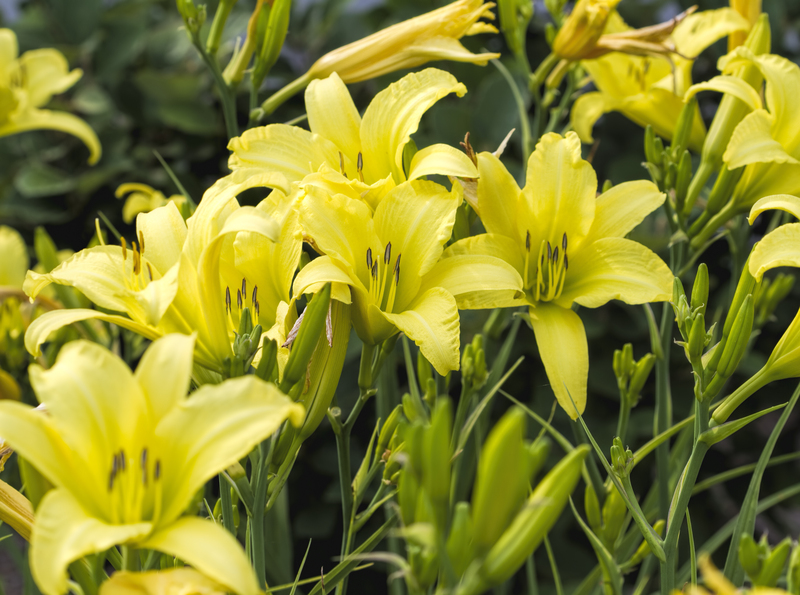The Art and Science of Vertical Gardening
Posted on 20/09/2025
The Art and Science of Vertical Gardening
Are you enchanted by the lush, green walls in urban spaces or dreaming of cultivating your own vertical oasis? Vertical gardening has emerged as a creative, eco-friendly, and efficient way to maximize growing space--bringing the beauty of nature to urban environments and beyond. Discover the art and science of vertical gardening, learn the methods, benefits, and innovations, and gain tips to embark on your own elevated garden journey.

Understanding Vertical Gardening: An Overview
Vertical gardening--also known as living walls, green walls, or vertical planting--refers to cultivating plants upwards rather than outwards, utilizing structures that allow plants to grow up walls, fences, or freestanding supports. From simple trellises to sophisticated hydroponic walls, the concept blends horticulture, design, and engineering, transforming blank spaces into vibrant, living works of art.
Why Consider Vertical Gardening?
- Space Optimization: Ideal for urban dwellings, apartments, or small gardens with limited ground space.
- Aesthetics: Adds visual appeal and a touch of nature to interiors and exteriors alike.
- Air Quality: Living walls can improve air purification indoors and outdoors.
- Insulation: Green walls help regulate temperature, providing natural insulation and reducing energy costs.
- Food Production: Enables cultivation of herbs, vegetables, and fruits in areas where traditional gardening is impractical.
The Artistic Approach: Design Principles of Vertical Gardens
At its core, vertical gardening is an artistic endeavor. Designers, landscapers, and enthusiasts treat walls as canvases, deftly blending colors, textures, shapes, and growth habits to compose living masterpieces. Here's how the creative process unfolds:
Color and Texture Selection
- Foliage Diversity: Intermingle broad-leafed tropicals with fine-leafed grasses for striking contrast.
- Flowering Plants: Integrate bright blooms to inject seasonal interest and attract pollinators.
- Layering: Arrange species according to height, sun, and water requirements to optimize aesthetics and plant health.
Patterns and Structures
- Geometric layouts: Use frames, pockets, and modular systems to create symmetry and visual rhythm.
- Organic compositions: Let plants grow more freely for a wild, natural look reminiscent of cliffside vegetation.
Sustainable Materials and Beauty
The artful integration of sustainable materials--such as reclaimed wood, recycled plastics, or biodegradable planters--elevates the ecological impact and visual harmony of any vertical gardening design.
The Science Behind Vertical Gardening
Beneath the lush surface, vertical gardens embody the intersection of botany, ecology, and technology. Success relies on understanding plant physiology, growing mediums, irrigation, and environmental control.
Choosing the Right Plants for Vertical Growth
- Light Requirements: Assess available sunlight--full sun, partial shade, or full shade--before plant selection.
- Root Structure: Select shallow-rooted species or those adapted for tight spaces, such as succulents, ferns, trailing vines, and many herbs.
- Size and Maintenance: Opt for compact, slow-growing, or frequently pruned varieties to ensure long-term manageability.
- Climate Adaptation: Use native or climate-appropriate plants for best health and sustainability.
Vertical Gardening Systems and Structures
The science of vertical gardening shines in the innovative systems developed to support upward plant growth:
- Pocket Planters: Fabrics or pre-molded sacks attached to walls, each holding soil and a plant.
- Modular Panels: Interlocking frames filled with a planting medium, allowing for customizable, scalable designs.
- Hydroponic Walls: Soil-free walls where roots are misted or bathed in nutrient-rich solutions--ideal for lightweight, low-mess installations.
- Trellises and Lattices: Traditional supports for climbing plants, such as jasmine, clematis, or ivy.
Irrigation and Fertilization
Efficient watering is crucial. Vertical gardens dry out faster due to greater sun and wind exposure. Automated drip irrigation systems or capillary mats are recommended for consistent moisture. Fertilization may also be required, usually delivered through irrigation for hydroponic or semi-hydroponic setups.
Soil and Growing Mediums
- Soil-based: Lightweight, organic-rich soils that retain moisture yet drain well.
- Soilless Mixes: Combinations of coco coir, peat, perlite, or vermiculite for roots to anchor while minimizing weight.
- Hydroponic Substrates: Rockwool, clay pellets, or synthetic mats that hold water and distribute nutrients directly to the roots.
The Benefits of Vertical Gardening
The art and science of vertical gardening delivers a wide array of benefits across environmental, social, and practical realms:
- Urban Greening: Converts sterile, grey structures into eco-friendly habitats for wildlife and pollinators.
- Food Security: Empowers communities to grow their own produce, reducing food miles and supporting nutrition.
- Air Filtration: Living walls remove particulates and toxins, improving air quality for building occupants and passersby.
- Temperature Regulation: Green facades provide shade and evaporative cooling, cutting air conditioning costs and heat island effects in cities.
- Noise Reduction: Thick plantings absorb acoustic energy, quieting busy streets and interiors.
- Human Wellness: Access to greenery has been shown to boost mood, productivity, and even patient recovery times in healthcare settings.
Best Plants for Vertical Gardens
Not all plants are created equal when it comes to vertical gardening. Choose species based on your climate, exposure, and maintenance preferences. Popular and effective options include:
- Ferns: Boston fern, maidenhair, bird's nest fern.
- Succulents: Sedum, echeveria, crassula, haworthia.
- Herbs: Basil, thyme, parsley, chives, oregano, mint.
- Vining Plants: English ivy, pothos, philodendron, creeping fig, jasmine.
- Ornamentals: Spider plant, peace lily, coleus, begonias, petunias.
- Edibles: Strawberries, cherry tomatoes, lettuce, baby spinach, dwarf peppers.
DIY Vertical Gardening: Step-by-Step Guide
Ready to create your own green wall? Follow these steps to craft a functional and beautiful vertical garden at home:
1. Assess Your Space
- Check sunlight exposure--south-facing for sun-lovers, north or shaded for shade-tolerant plants.
- Measure your available wall or fence area.
- Ensure structural support for weight (especially on balconies or fences).
2. Select Your Structure
- For small projects, try wall-mounted pocket planters, recycled pallets, or stackable pots.
- For larger installations, consider modular panels or hydroponic systems.
3. Choose Your Plants
- Read up on preferred species for your conditions and design goals.
- Combine varieties for interest, function, and seasonality.
4. Prepare the Growing Medium
- Mix lightweight potting soil or select a soilless substrate as needed.
5. Install Irrigation
- Hand-water small gardens, but use drippers or soaker hoses for larger setups to ensure thorough hydration.
6. Plant and Maintain
- Arrange plantings densely to minimize bare spots.
- Prune, feed, and monitor soil moisture regularly.
- Replace or trim plants seasonally to refresh your garden.
Challenges and Solutions in Vertical Gardening
Like all gardening methods, vertical gardening comes with its unique set of challenges:
Common Issues
- Water Runoff: Water may drain too quickly from upper levels, starving lower plants.
- Pest Management: Tight plantings can harbor pests and diseases if not monitored.
- Weight: Soil and water add significant weight, requiring sturdy supports.
- Sunburn or Shade: Uneven light exposure can stress some plants.
Practical Solutions
- Use of Retentive Soils: Opt for soilless mixes that retain moisture.
- Install Automated Irrigation: Ensures consistent watering throughout the garden.
- Frequent Inspection: Quickly address pests, adjust irrigation, and remove unhealthy plants.
- Structural Checks: Regularly inspect your wall or support frame for signs of dampness, mold, or mechanical wear.
Innovations and Trends in Vertical Gardening
The world of vertical gardening is expanding rapidly, with innovators pushing the limits of technology and creativity:
- Smart Green Walls: Integrating sensors and IoT devices for monitoring plant health, humidity, and water needs in real time.
- Modular Living Walls: Systems that allow quick swaps of plant panels for dynamic, ever-changing displays.
- Biophilic Design: Architectural trend incorporating living walls in office buildings, hospitals, and homes for health and productivity benefits.
- Edible Green Walls: Urban agriculture projects transforming rooftops and office facades into productive growing spaces.
Caring for Your Vertical Garden
To keep your vertical garden lush and healthy:
- Water Consistently: Set reminders or automate watering, especially during hot or dry periods.
- Feed Your Plants: Apply diluted liquid fertilizer as needed, especially for edibles and flowering species.
- Prune Regularly: Trim dead or overgrown foliage for plant health and aesthetics.
- Watch for Pests: Inspect leaves and soil frequently; treat problems early using natural or integrated pest management techniques.
- Rotate Plants: Occasionally swap out plants for visual variety or to accommodate changing light conditions year round.

The Future of Vertical Gardening: Greener Cities and Beyond
From humble balcony planters to monumental architectural installations, vertical gardening continues to transform our built and natural environments. It represents an exciting frontier for art, science, and sustainability. As technology advances and ecological concerns grow, expect to see living walls becoming a staple of future urban landscapes--improving lives, biodiversity, and our connection to the natural world.
Conclusion: Elevate Your Gardening Experience
The art and science of vertical gardening offers a unique opportunity to merge beauty, utility, and environmental stewardship. Whether you're a city dweller with limited space or a homeowner seeking a spectacular garden feature, vertical planting can elevate your green ambitions. As you experiment and innovate, you'll find that the vertical garden--a living tapestry--brings inspiration, health, and joy to any space.
Ready to start your own vertical garden? Embrace the canvas of your walls, mix creativity with horticultural know-how, and watch your living masterpiece grow upwards!

